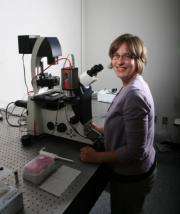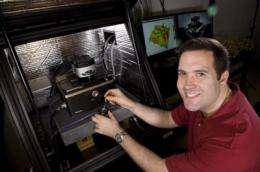UH engineering professors featured in consecutive issues of Science

Researchers can spend entire careers producing outstanding work but still not see their efforts featured in the pages of Science, one of the world's most prestigious scientific journals. That won't be the case, though, for two junior faculty members in engineering at the University of Houston (UH).
Jacinta Conrad and Jeff Rimer, both assistant professors in Cullen College of Engineering's department of chemical and biomolecular engineering, had papers featured in consecutive issues of Science this month.
"Jacinta and Jeff are both extremely promising young researchers," said Ramanan Krishnamoorti, chair of chemical and biomolecular engineering at the Cullen College. "I expect that this is the first of many successes they will encounter in their independent careers. They are both excellent additions to this university."
Conrad's paper, which she co-lead authored with UCLA graduate student Maxsim Gibiansky, appeared in the journal's Oct. 8 issue. Conrad started this work during postdoctoral research at the University of Illinois at Urbana-Champaign. The article revealed a newly discovered method that bacteria use to move. Using hairlike appendages known as pili, some bacteria are able to pull themselves upright and "walk" across a surface. This research has ramifications in any number of fields, from food production to military transport.
Conrad's research team conducted its work by translating microscopy movies of bacteria into searchable databases of bacterial behavior. The ability to walk, she said, allows these bacteria to explore their environment by efficiently covering large areas before forming biofilms – colony of bacteria living on a surface and protected by a matrix of long molecules. Biofilms are problematic in a number of different industries and applications. In food production plants, for example, they are a prime cause of food contamination. Biofilms also increase the drag on oceangoing vessels that the U.S. military counteracts with often-toxic compounds. In hospitals, they are implicated in up to 80 percent of all non-specific infections.

This research provides insight into how biofilms form and offers a possible method of combating them. The chemistry of a surface, for instance, could be changed to reduce the ability of pili to stick to it, or the surface could be made rougher or smoother in a way that hinders bacteria movement and biofilm formation. Conrad said this work shows that how individual bacteria move on a surface impacts the structure of the biofilm they form. So, designing surfaces that change how bacteria are able to move might be a very directed and rational way of preventing biofilm formation.
Rimer's article was published in the Oct. 15 issue of Science and was featured on the magazine's cover. He conducted this work as a postdoctoral researcher in the lab of Michael Ward at New York University's Molecular Design Institute.
This research explores two possible drug targets for combating a rare type of kidney stone. While roughly 10 percent of the country suffers from calcium-based stones, some 20,000 people in the United States have stones caused by a genetic disorder causing a buildup of the amino acid L-cystine. These kidney stones form more frequently than calcium-based stones and are far more debilitating, with most patients requiring regular dialysis and unable to work. The common prescriptions for L-cystine stones include restriction of dietary sodium and protein intake, high fluid intake and medications that react with L-cystine to form more soluble molecules yet have troubling and sometimes serious side effects.
In the article, Rimer and his colleagues outline the effectiveness of two molecules, known as "tailored growth inhibitors," in preventing the growth of L-cystine-based crystals. Rimer's research showed the inhibitors resulted in a 1000-fold decrease in crystal volume. What happens in the presence of these inhibitors, Rimer said, is that the preferred direction of crystal growth is hindered, causing a shift in size and shape from large platelets to much smaller needles. Not only do smaller crystals form, but they also appear less likely to aggregate into stones.
While these results are based on laboratory testing and not human or animal models, they have clear implications for those suffering from L-cystine-based kidney stones. With smaller crystals and the likelihood of less crystal aggregation, fewer stones should form. Instead, L-cystine will primarily remain dissolved in urine and eventually expelled. The next steps of this research will be carried on at the NYU School of Medicine.
According to Joseph W. Tedesco, Elizabeth Rockwell Chair and Dean of the Cullen College, it is no coincidence that the same department has two young faculty members featured in such a prestigious journal.
"The Cullen College is in the process of increasing our faculty count by 30 percent," Tedesco said. "Drs. Conrad and Rimer both came to the college as part of this drive. Their efforts, along with the efforts of all our faculty members, will allow us to grow our research expenditures and help the University of Houston earn designation as a tier-one research university."
More information: For Conrad's paper, visit www.sciencemag.org/cgi/content/short/330/6001/197 . For Rimer's paper visit, www.sciencemag.org/cgi/content/short/330/6002/337 .
Provided by University of Houston


















